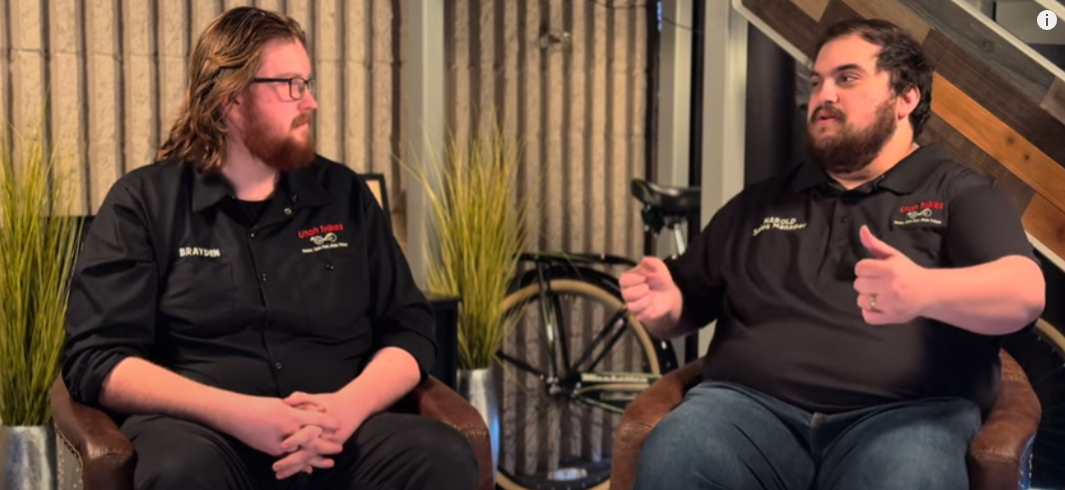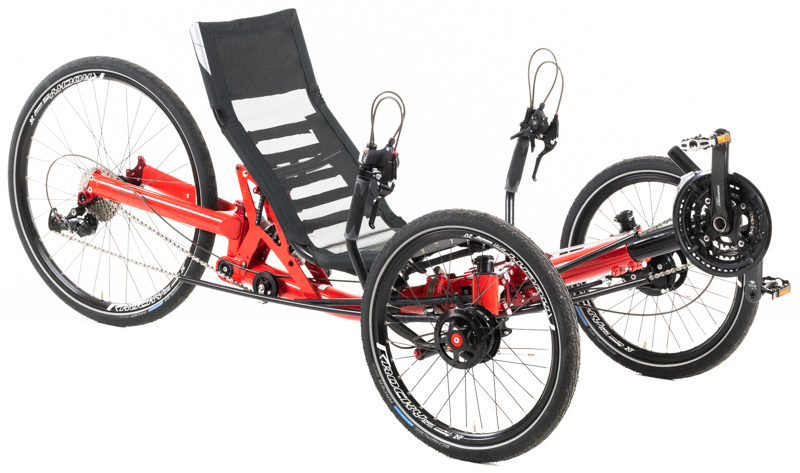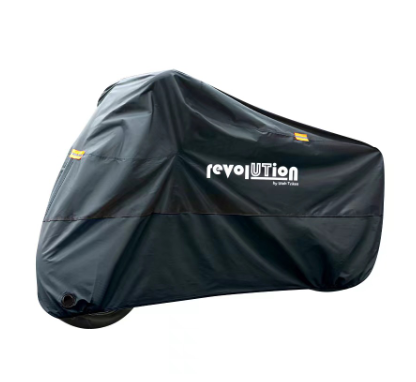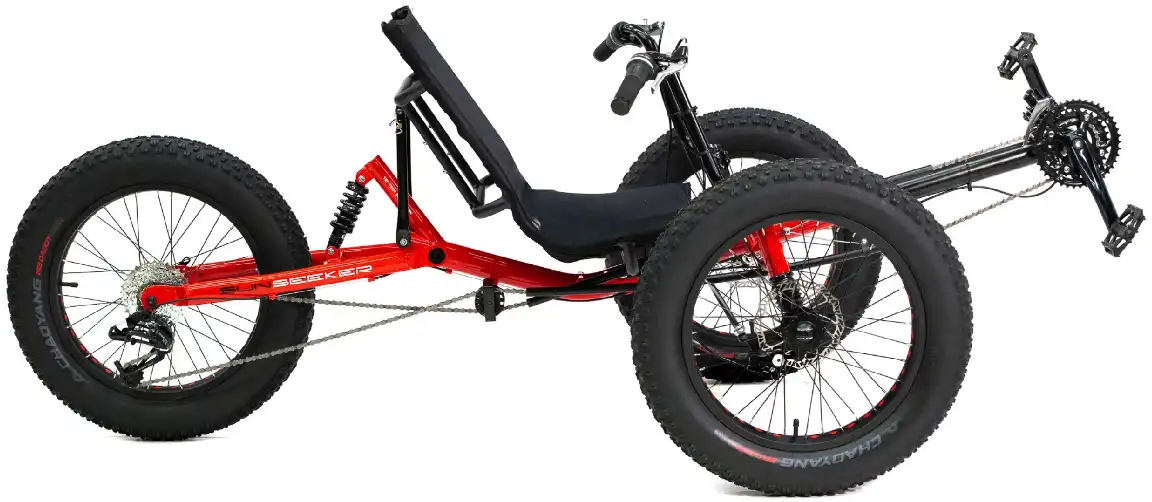
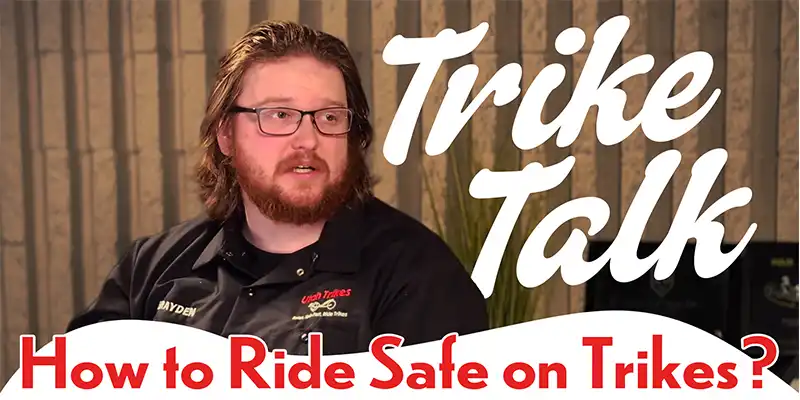
Trike Talk Ep 5: Ride Safe In Bad Weather With These Expert Tips
Published on 03/26/2025
Harold: Hello everyone! I'm Harold,
Brayden: And I'm Brayden.
Harold: We're here to talk trikes.
Harold: We know that sunny days are upon us, even though it's snowing today, and it's a little cold and miserable. But, we have a lot of people across the states and all over the world who are finally able to get out and ride. The main obstacle for you guys to be able to do that is going to be the weather, and we're going to talk about a couple of things that you can do to be a little bit more weatherproofed and ready to ride.
Brayden: Yes, we want you out there!
Harold: Right now, as we're heading into the season, it's more important than ever to make sure that your trike is, of course, ready to ride. A couple of things that you can do before you get started is make sure that your chain is adjusted properly. Make sure that your chain is lubricated as well. This is going to be the only case when you're riding in wet conditions that we recommend you use a wet lube instead of a dry lube. That's going to run a little bit better in these watery conditions we have, at least around here.
Harold: Other basic maintenance things you should be aware of as well: make sure that your brake cables are adjusted, your shifter cables too.
Brayden: Now is the time to come do it right. If you're going to get a tune-up, and could get a tune-up, and you're going to be riding this season, bring it in now. That way, we're not slammed here. Absolutely! We're starting to see our local tune-ups increase in frequency, so if you can get your tune-up in as quickly as possible, it's also going to relate to how quickly you can get back out. We want it prepped and ready for you to ride as soon as you can.
Brayden: Speaking of bringing it in here, if you're not local and can't bring it to us for tune-ups, bring it to a trusted bike shop.
Harold: Absolutely! They should be able to work on your trike; all of the components are the same.
Brayden: I'd also like to mention, if you are looking to get into a trike, now is the time. Get it now and get it ready for the season. It's a lot easier to get a hold of them now than come mid-season when we get really busy,But with that out of the way, let's talk about the weather. Absolutely! What is your number one thing when you're getting out there riding and it starts to get cold and chilly? What do you do first?
Harold: I make sure I have a good coat. Yeah, first thing, you're going to be riding in cold conditions, even beyond getting a trike. Make sure that you yourself, the rider, are warm and as comfortable as you can be. You don't want to go out riding in a t-shirt and shorts just yet. I know I'm excited for those times, but you know, get a coat, stay warm, get hand warmers. You don't want to get frostbite on these things. Second thing, of course, you want to consider is if you're going to be riding in more of the wet conditions. You want to get fenders on your trike if you don't have them already. Specifically, you want to get a rear fender if your trike is compatible with that. If you think about where you're sitting on all these recumbent trikes, where's your back at? Right underneath the rear wheel. Unless you want to get a nice clean streak of water, mud, and whatever, get a fender, at least the rear. Fronts are good too, with the tadpole trikes specifically. As you start to turn, where's that water going? It's going on, and I'm sure most of you don't want to take a shower while you're on a trike. So, getting fenders is always going to be a good idea, even if it's not rainy. You just want to avoid getting road debris.
Brayden: I'm glad you said that. When you say, "not raining"? Is there a situation where you start riding in a rainstorm, are front fenders going to keep you dry, or are you going to get wet because you're out there in the rain?
Harold: If it's rainy and it's wet, you're getting wet. I'm sorry.
Brayden: So, dress appropriately.
Harold: Dress appropriately. Check the weather for your riding day. You don't want to be caught unawares. I mean, it's hard to predict weather in some cases, especially here where we live, but be prepared. Boy Scout motto: be prepared, and you'll be happy.
Brayden: Of course, a good coat, long pants, gloves work just fine on these. Your hands are going to be up here or up here, depending on the trike, so getting some good gloves to keep your hands warm, that's important too.
Harold: Absolutely. So, talking about wearing a good coat and staying prepared.
Brayden: I think it's also important that you layer up, just on the off chance that the sun does peek out. You don't want to get out there and get all sweaty while you're riding.
Brayden: something you can take off and throw on that back cargo rack or whatever bag storage unit you've got with you. Another thing to keep in mind: longer-tailed coats will get caught in those wheels, so make sure everything's at least up and tucked or, at the very least, not dragging or hanging down.
Brayden: Speaking about storage, where you throw those extra layers in those bags, what do you do in the situation where you have clothes you want to throw in the back? What bag options do we have, and what bag options do you prefer?
Harold: It's going to depend on what you're carrying. I'm going to address what you should get if you're going to be carrying a coat or anything. If you're not going to be taking a lot with you and your cargo needs are going to be lesser, a trunk bag like those offered by Arkel, Seymour, and other bag companies is going to be enough. They're not very big, but they are going to be ideal for carrying a phone, carrying a wadded-up jacket, and things like that. Of course, as you're starting to add more and more stuff with you, pannier bags are going to be better options there, like the Arkel and more bags that we carry, and our new Revolution pannier bags are great. Another great thing to consider is that adding on a pannier bag is also going to make your rear end on the trike a little bit wider, a little bit more visible.
Brayden: A lot of them come with a lot of reflective material too, so you know, as it gets rainy and a little foggy out there, that reflective material is going to help you be seen a little bit better. And just to throw it in there, a lot of our pannier bags and our top trunk bags that we carry, at the very least, are waterproof or water-resistant to some degree, so that's important.
Harold: yeah, especially if you're going to be riding now that it's cold and rainy,
Brayden: Trying to brave that weather.
Harold: You mentioned visibility, which is great. That ties into the next thing I wanted to bring up. Of course, you know, in these low-light conditions and foggy weather, you want to make sure that you're as visible as you can be, so headlight, tail light, flag. You want to make sure you're wearing reflective clothing. Make sure that every part of your trike is as visible as it can be, even if that comes into you attaching reflective tape onto the rims or wearing reflective ankle straps. One other thing I should mention: as you're riding in these really windy conditions, we've had a lot of people being concerned about their flags being swept up. You can just take a zip tie to your flag itself and zip tie that to the flagpole, and that'll keep it on there.
Brayden: Yeah, I've heard it a couple of times, especially with those Catrike flags. Just using something to secure that flag down,
Harold: exactly, that'll be enough to avoid any headaches and another flag purchase.
Brayden: Of course, another flag, you can never have too many.
Harold: Oh yeah, one nice thing about a tire brand that we carry a lot of and we're big fans of, the Schwalbe Marathon tires, all come with a reflective strip on the side of the tire, which is going to increase your visibility some more.
Brayden: Speaking about tires, we carry a special winter tire made specifically for snow. It's not really a best all-rounder. It's kind of like a street tire on your car tires. You wouldn't want to run your winter tires all year round, but these are going to be the best option for strictly snow riding. More general options, right? The fat tires are going to do great in extreme weather conditions, wet mud, snow, anything that has that much tread and knobbies on it.
Harold: Any tire with knobbies on it is going to have a lot more traction than any tire without. You don't want to take something like a very smooth line tire and try running that on the snow unless you're drifting.
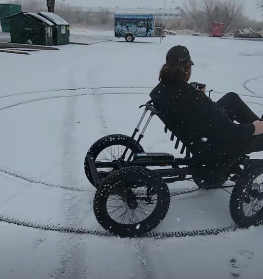
Brayden: which, you know, is awesome, all the power to you. But if you're looking for traction, especially in those worse climates, mud, a knobby tire is going to suit you best. In fact, while we're talking about it, running a lower tire pressure will actually get you more traction than running those High Press street tires you've got.
Harold: I mean, that's something to keep in mind even with the standard road tires too. If that's all you have available and you're in a dangerous scenario, um, take the tire when at a lower tire pressure, get more traction, get home, and be safe.
Brayden: Yeah, oh yeah, of course, be sure to stay in that recommended PSI pressure. It is written on your sidewall, it will be there.
Harold: Uh, while we're talking about tires and things that make you go, let's talk about things that make you stop, your brakes. Well, most of the trikes we have here have disc brakes. Uh, good option to have is the drum brakes as well. If you're worried about maintenance in particular, they're completely sealed, so unless you're riding the trike underwater for whatever reason, you really don't have to worry about keeping those clean. But, um, those are only going to be seen on European trike Brands like ICE, Azub, HP Velotechnik. What we have here is mostly going to be the disc brakes, which are great too. They have a lot of stopping power. Um, but you have to keep in mind since you have a rotor and caliper that is exposed if those get dirty in any way, um, you're going to have more issues with stopping and being able to get to a quick stop. So, it's important for you as you're doing your daily maintenance on the trike to also make sure that your rotors and calipers are cleaned, and you can do that with isopropyl alcohol and a rag. It's not too bad to do. You might need to have a spotter to help you keep that wheel up, but not too bad.
Brayden: You know, one of the things I see all the time is people complaining about how loud their brakes are, right? Sounds like a dump truck as I'm trying to close my brakes. A lot of that can be resolved just by keeping those brakes clean, right, and debris-free. Hey, you mentioned earlier using a wet lube for these colder conditions and then a dry lube for drier conditions. Will you just explain that a little more?
Harold: Yeah, of course, um, most of the time you are going to be using a dry lube because you're going to be riding in dry environments. Um, if you think about where the chain is on all the recumbent trikes that we work with, it's going to be close to the ground, and what's close to the ground too? Dirt. Um, so you want to make sure that you're not getting a lube that's going to be picking up dirt as you ride because if you get dirt in your chain, that's going to grind down your gears, grind down your chain, and really result into an expensive fix eventually. Um, so do that in the summer months. What's your other enemy that you have to work with in the winter spring season? Water.
Brayden: So, what what do you use instead do you use a wet lube?
Harold: Um, so you would use something like a wax or a grease lube to keep you from picking up excess water, getting rust into your chain, just to keep you riding smoothly and not having to worry about it as much.
Brayden:, Well, we're talking about wet and dry lubrication, we have more things that need to keep lubricated than just the chain. What options do we have for those?
Harold: Something like cable magic for your shifter and brake cables. Um, we can put that onto your cables here. You can do that yourself, of course. We see all the time where people have been riding their trikes during the winter and now they have rusted-over cables because they didn't do anything to protect against it. So while you're doing all of your chain protection, also make sure that you apply some sort of wet lube onto your cables as well so you don't have any rust.
Brayden: Want these trikes to last. Less maintenance the better. Preventative maintenance.
Harold: Headaches now versus migraines later.
Brayden: We've talked about preventative maintenance. We've talked about some of these accessories you can have on there to prevent these wet conditions from harming a little bit more. Say you're going out there, you are braving the weather, it's a little snowy, maybe a little rainy, what obstacles, what things do I need to keep in mind to keep me safe while I'm out riding?
Harold: Just your general road conditions like you would do if you were riding your bike normally. You want to make sure that you're not running into any manhole covers. If it's icy, they'll take you out. Painted lines or anything like that. Of course, you want to avoid potholes already, but if you are doing that, um, make sure there, you know, how deep they are, or you want to just keep avoiding them in general.
Brayden: It's important to also know you are on a trike, right? A little bit lower to the ground, a lot more traction. Your center of gravity is a lot lower, so your likelihood of tipping over is a lot less on the trike, right?
Harold: One less thing to worry about as you're dipping, dodging all these potholes all around you. Um, there's not a whole lot around depending on where you're at.
Brayden: and there really isn't a whole lot. I mean, you're not going to fall very far.
Harold: No, already. I mean, the main thing I would be concerned about is if you're going to be damaging your rim or your tire or things like that. Um, but those are some things you want to keep in mind. Generally, just the road conditions of where you're going to be riding. If it's icy, what's the condition of the road.
Brayden: and know that those colder weathers. I mean, we've already talked about it before, your braking distance is going to be increased, Know that if you do have to make an emergency stop, maybe stick to those lower gears. It's a little easier to start next time, Things to keep in mind.
Brayden: So talking about riding that trike, braving the weather out there, very I mentioned cleaning your brake discs, making sure those are clean, but it is just as important to make sure the whole trike is clean after riding,
Harold: Right? And don't wait to do it. We've seen it happen enough where people will go on their final ride for the season, store it away, wash the hands of the trike (and then they'll bring it to us because they have a mud monster on their hands filled with rust). It's terrible to look at, costs a lot to clean, and it's also very time-intensive and expensive to clean. As soon as you are done riding for the day in any condition, go over your trike. Check your cables, check your chain, all these other maintenance things that we've talked about previously, but also make sure your trike is clean. That's the easiest thing you can do for it. Take care of your trike; it's going to take care of you.
Brayden: Back to that preventative maintenance, I mean, leaving water and sediment sitting on that trike is going to rust things out a lot, potentially damage your frame. I mean, let's keep them clean, and let's stay maintaining them.
Harold: Keep riding, keep riding, keep riding, keep cleaning.
Brayden: So, right back into cleaning. You finish cleaning; you're going to store it now. Of course, putting it in a garage is always going to be the best, but not everybody's in that situation where they can store it in their garage. So, we have tarp options, we have trike covers. Whether you're using a tarp or one of our covers, please make sure it's dry before you cover it. Right? You don't want it sitting in a dome just festering.
Harold: So, right, it's metal, it's a metal trike, it's going to rust if you don't keep it dry. Do that before you put it away in any way.
Brayden: Not saying you have to do a whole deep clean, but make sure it's dry before you throw it under that tarp.
Harold: I'm surprised we haven't brought this up yet because we're always yapping about it. Sure, motors, and these motors, and using these motors in these bad conditions. Can I still use a motor while it's poor riding weather?
Brayden: Absolutely, yeah. I mean, they're designed to be used, not necessarily abused. So, keep in mind that there are some things to keep in mind while you're out there in those colder, wetter conditions. Of course, all of our motors are to some degree a little water-resistant, right? Not necessarily waterproof, but they can take some abuse out there. So, don't be too concerned about taking your battery, the motor itself, or any of the cabling out into wet areas. Right? All of those connections are made to be water-resistant. The motor is pretty sealed. The battery is sealed to a degree. I do think it's the part to be most concerned about.
Harold: Right? You still have that charging port on the battery, and then you have that sled right underneath it where if any water gets in, you're going to have problems.
Brayden: Right? So, I mean, of course, preventative maintenance, back to our last subject. After you're done riding in these wet conditions, bring it back. One, go over your motor, go over your cabling, especially go over that battery. Remove that battery, check your charging port, make sure that is dry right before you plug into the charger. But, of course, check out the sled as well. Make sure that those connections and pins on both the battery side and the trike side are clean, so next time you go to make a contact, there's not any wet, you know, causing any sort of electrical shortage or issue down the road.
Harold: Right? One thing to keep in mind just for riding when you're riding in colder weather, you can expect to get less range from your battery than you would be in hotter weather. In the summer, typically in the summer where you're going to get about 20 miles of range out of one battery, I expect at least half of that depending on if it's near freezing. Even if you're in the spring and it's starting to heat up and you're still riding in the snow, still account for you're going to have less range than you normally would if you are going to be riding.
Brayden: We have talked about range in a previous video, but again, just another factor to throw in. The weather is going to dictate how far you can push that trike, and especially the cold.
Harold: Dang it, why can't it just be simple?
Brayden: I wish I could just give you an answer, 'You're going to get 60 miles on this one battery, flat guaranteed, every time.' Unfortunately, we can't do that.
Harold: It's all approximates, but if you want to know what are approximates, go watch our other video.
Brayden: Yeah. Last thing to say, just to add it while we're talking about the battery, after you're done drying it off in that wet, cold condition, bring that battery inside. Don't store it outside in those freezing cold temperatures.
Harold: You wouldn't store a puppy outside in the cold, would you? Think of it like that. Think of your battery like a puppy, and then you would not leave it out in the cold or in the extreme heat.
Brayden: Yeah, I'd argue that further. Don't leave it in the heat either. Right? These are best kept in a room-temperature environment, so whether that's a heated garage or just bring it inside after a rainy day. Make sure you get that longevity and the longest lifetime you can out of these batteries.





